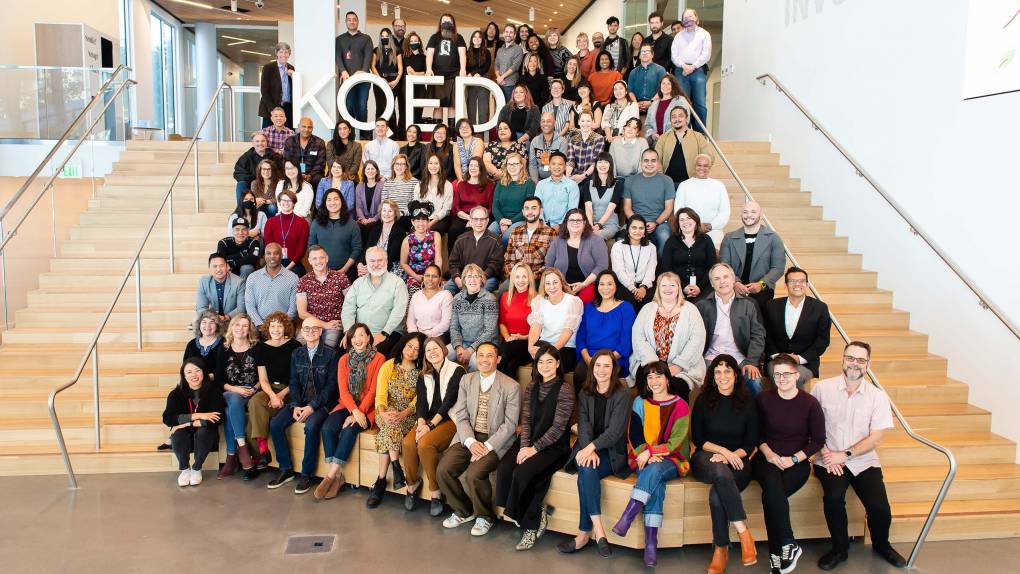Diversity, Equity and Inclusion at KQED: 2022Diversity, Equity and Inclusion at KQED: 2022
Independent public media is a treasured resource. However, to truly serve the public we have a responsibility to reflect and fully represent our diverse communities and their experiences.
Investing in DEI
In 2022, KQED devoted considerable time and resources to advancing our diversity, equity and inclusion (DEI) goals and meeting the challenges outlined in our 2021 DEI Impact Plan and Report.
In December 2021, the station conducted another staff Inclusion and Engagement Survey. While we saw small improvements in our scores from last year’s survey, the scores remained lower than results seen at other nonprofit and media organizations. More significantly, we saw disparities in the experiences of women of color, all people of color, LGBTQIA+ and staff over age 45 from those in nonmarginalized groups. KQED partnered with the DEI strategy firm Brevity & Wit (B&W) to help us understand these results and to provide support in achieving the desired changes in our workplace and in our work serving our Bay Area communities.
Based on staff input, KQED made the decision in early 2022 to seek a Chief DEI Officer, who will report to the president and CEO and serve on the Executive Management Team (EMT), to lead DEI. The 360 Group, an executive search firm, has been retained to help the station find our new DEI leader. Two additional internal positions will be hired in FY23 to support DEI initiatives.
A New Vision for DEI
In 2022, much of our work was focused on developing a new strategic plan for KQED. DEI is foundational to this plan, and created a need to update KQED’s DEI vision statement to help the organization chart its course for the next three years. We used the following inclusive process to draft our DEI vision:
- The EMT developed the first draft of a vision based on findings from the employee engagement survey data and using the Radical Product Thinking approach.
- B&W integrated feedback from KQED’s staff Diversity Council.
- The vision was updated by B&W based on feedback about the root causes of DEI issues expressed through a series of focus groups and open office hours with staff.
- Staff feedback on the revised vision was collected through a survey and an input session.
- KQED’s Community Advisory Panel and board DEI Task Force also provided critical input.
With this input, KQED finalized its vision for DEI for the next three years:
KQED DEI Vision
KQED envisions a public media organization with a culture that centers on human dignity, equity and belonging. This will enable us to better serve and reflect the Bay Area through diverse and inclusive storytelling.
KQED will do this by:
- Creating equitable policies that strengthen trust.
- Pursuing excellence without the toxicity of perfectionism.
- Setting reasonable timelines and goals that are aligned across departments.
- Communicating clearly and consistently.
- Applying best practices for inclusive and effective decision-making.
- Engaging in respectful conflict and building bridges across differences.
- Creating an environment both within KQED and the greater Bay Area where everyone feels respected, valued and heard.
Taking Action: Staff and Board
To realize our new DEI vision, KQED is committed to several short-term and long-term action items. Action planning is structured in two phases: 1. Immediate, short-term actions to be taken by leadership, and 2. longer-term actions that will be led by our new Chief DEI Officer. This will enable KQED to move forward with necessary steps while saving much of the long-term action items for the Chief DEI Officer, who will make KQED’s DEI vision a reality.
Our 2022 short-term action items are still in development, but will focus on the specific DEI priorities of the employees in each division: Content, Product, Revenue/Audience and Operations. Staff will be invited to participate in listening sessions and, through a survey, to provide input into the changes they would like to see implemented in their divisions to advance DEI.
KQED’s board of directors is also committed to DEI. In addition to their continued success in recruiting a diverse slate of board members each year, the board centered on DEI at their annual retreat. Part of the day was spent with experts discussing and learning DEI best practices. The board also provided input into KQED’s vision for DEI for the next three years. In 2022, the board created a DEI Task Force focused on ensuring the organization establishes and meets annual DEI Key Performance Indicators (KPIs).
A Report on Our Progress
In our 2021 DEI Impact Plan and Report, we committed to taking several short-term actions. Though we didn’t complete all of them, we did make progress in other important areas as shown above. Our 2021 action items are listed below with an update on the progress made in the past year:
- Clarify roles and responsibilities of the Diversity Council: The Diversity Council, working with B&W, has made progress on its charter, which will be finalized when the new Chief DEI Officer is on board.
- Restructure Employee Resource Groups (ERGs) for a hybrid workplace: These groups — Parents and Caregivers Together; Women’s Network; LGBT@Q; Racial and Ethnic Diversity Resource Group — continue to exist virtually as Slack channels this year. The Slack Affinity Spaces — including BlaQ, AAPI and Aqui Estamos — also continue this year. The new Chief DEI Officer will lead the efforts to support our ERGs and Affinity Spaces to build community in a psychologically safe environment within the station’s hybrid work model.
- Provide transparency in compensation practices: In 2022, KQED’s Human Resources (HR) department published and led staff information and training sessions detailing how compensation is determined at KQED. Internal legal counsel also completed the annual equity pay analysis. KQED will pilot adding salary pay ranges to job postings beginning on 10/3/22. KQED is currently piloting the addition of this language on postings: “Salary range information will be provided to applicants who are contacted for an interview.”
- Offer workshops and training sessions to establish DEI norms and behavior expectations: These programs did not not launch in 2022. Instead, the organization chose to save these programs for the new Chief DEI Officer to develop and lead. KQED’s leadership team did engage in inclusive-leadership training during 2022 led by B&W.
- Launch a 360-feedback program for leadership: This program has been launched and will be completed, to the Executive Director level, by 9/30/22.
Diversity Hiring Goals
KQED engages in outreach to attract employees who reflect the diversity of the Bay Area. KQED’s hiring goals over the past several years focus on increasing Black, Indigenous and People of Color (BIPOC) representation in leadership at KQED and increasing Latinx and Black representation through the entire organization to more closely match Bay Area demographics. KQED engages in the initiatives described below to accomplish these goals:
- The station attended nine career fairs at local colleges and universities, including three local California state universities.
- KQED participated in the Public Media Village and sent its journalists to the National Association of Black Journalists, National Association of Hispanic Journalists, Asian American Journalists Association and National Lesbian and Gay Journalists Association conference job fairs.
- For all roles, KQED seeks to interview a diverse slate of candidates for its job openings through broad outreach and networking. For a more detailed description of KQED’s efforts to reach a diverse candidate pool, please see its EEO Public File Report for 2022 (PDF).
- At the application stage, KQED asks all job candidates to explain how they will contribute to its DEI efforts if hired.
- To encourage diverse applicants, all job postings contain this language: “We value the contributions of marginalized people in society — including Black, Indigenous, and all people of color, people with disabilities and LGBTQIA+ people — and we believe that these communities must be centered in the work we do, and we strongly encourage members of these communities to apply.”
- KQED provides training to hiring managers on Disrupting Unconscious Bias in Recruiting and Hiring.
- KQED will pilot the addition of salary ranges on its job postings starting on 10/3/22. Currently, we’re adding this language to postings: “Salary range information will be provided to applicants who are contacted for an interview.”
In the past year (8/1/21-8/1/22), KQED hired 59 regular and limited-term employees (employees hired for a specific period of time); 59% of those positions went to BIPOC individuals and 56% to staff identifying as female.
When we look at our broadest pool of hires, which also includes our on-call and temporary staff, 63% of those newly hired identified as BIPOC and 57% as female or nonbinary.
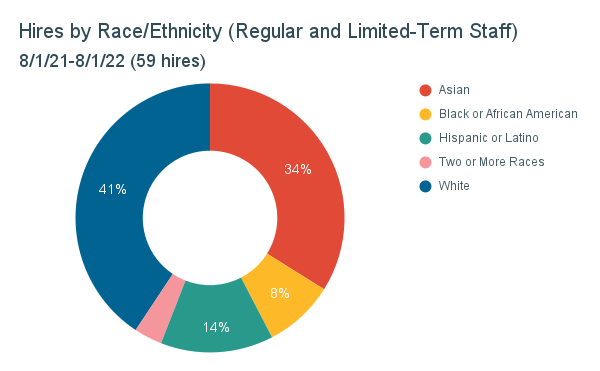
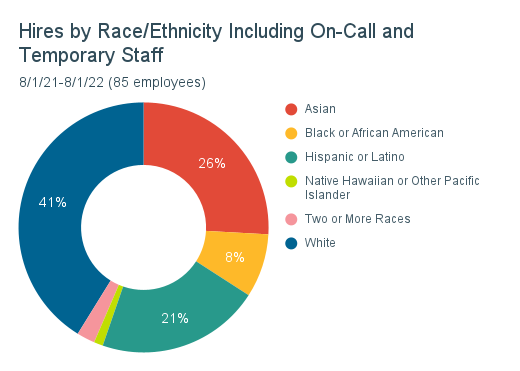
Other Demographic Data
The demographic information below reflects the results of these efforts between 8/1/21 and 8/1/22. However, like many other organizations operating during the pandemic KQED experienced an increase in staff resignations and has been challenged by a more competitive labor market when hiring.
Overall Make-up of Regular Staff by Race, Ethnicity and Gender
The station made progress from last year in increasing Asian staff and those identifying as Two or More Races, but experienced a decrease of 1.6% in Black/African American employees. In terms of gender, 61% of KQED staff identify as female or nonbinary. For this chart, we count our regular staff as well as our limited-term staff (employees hired for a specific period of time).
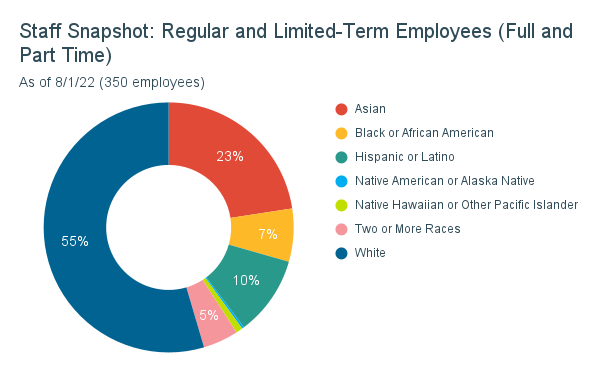
Note: The graph above reflects KQED’s staff race and ethnic representation in the context of the broad demographic categories recognized by the federal government. While KQED also offers more nuanced categories for staff to select race and ethnic identity, demographic trends from year to year are more evident when organized in the larger federally-mandated categories.
Our temporary and on-call staff play important roles at KQED. The chart below reflects the composition of our staff including these positions.
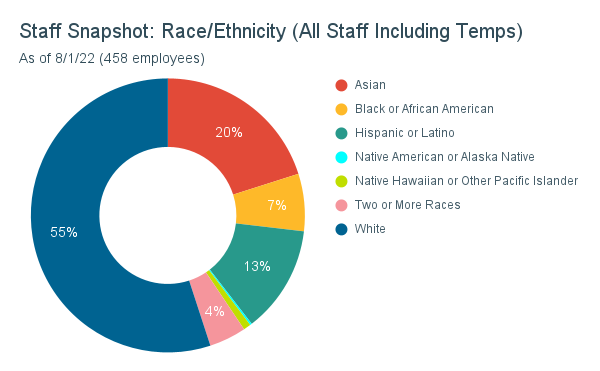
Internship Programs
KQED has an internship program that enables people to gain media experience and enhance their education. In 2022, we hosted 45 interns in eleven different types of internships. We provide a fully paid program for periods of six to twelve months. We selected from a diverse pool of candidates with 76% of our interns identifying as BIPOC and 69% identifying as female or nonbinary.
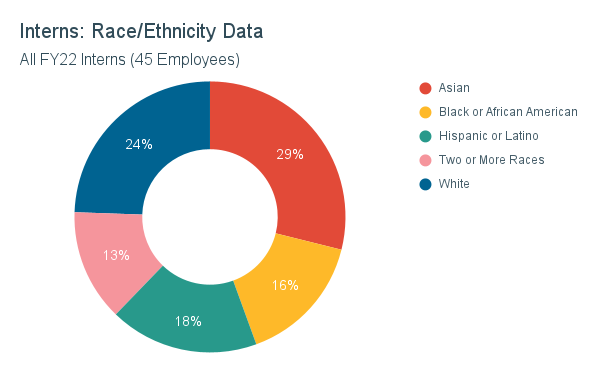
KQED also participated in the Raul Ramirez Diversity in Journalism Fund Internship program, which focuses on furthering the cause of diversity in journalism and promoting diverse voices in journalism over the course of the internship. The station also participated in a Science News Photojournalism internship through San Francisco State University intended specifically to offer this opportunity to underserved students.
KQED also hosted an Achieve Global Intern in the Development department. Achieve Global is an organization that focuses on underserved high school students from low-income families. The internship is meant to open up career exploration opportunities for students in the Bay Area.
We created and hosted a Youth Takeover Week again this year. One of the goals of the program is career exposure. Students and staff engaged in conversations about job opportunities at KQED and their past work experiences. KQED hosted more than ten different local high schools.
Comparison of KQED Staff to the Overall Bay Area, the Market and Our Audience
As mentioned earlier, KQED’s goal is to be representative of the public we serve so we map ourselves against the overall Bay Area demographics and our audiences to measure our progress. KQED will continue to work on hiring and retaining more Hispanic/Latinx and Black/African American staff, and to bring more BIPOC employees into leadership roles.
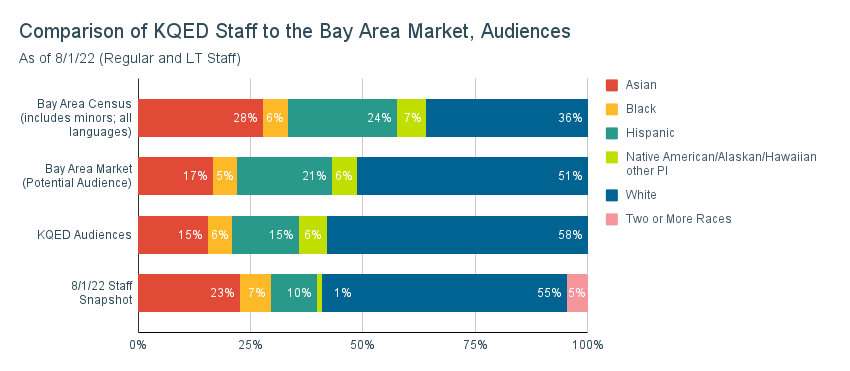
Note: U.S. census, market and audience surveys attribute race fractionally. KQED offers a “Two or More Races” option per federal EEO requirements.
Demographic Changes Over Time
KQED also measures its progress over time. This assessment shows we need to do more to recruit and retain Hispanic/Latinx and Black/African American staff.
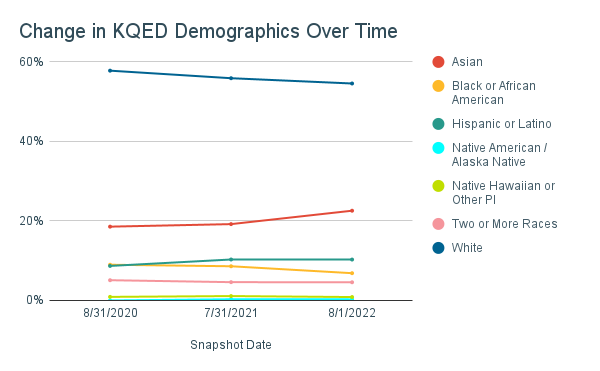
Promotions
We learned from our 2020 Inclusion and Engagement Survey that staff did not have a clear understanding of the process and criteria for job promotions at the station. Staff identified a lack of transparency and inconsistency in awarding and communicating promotions, creating concerns about potential inequity in the process. In 2021, as part of the survey action items, KQED convened a working group of cross-functional staff to collaborate with Human Resources on creating greater fairness and transparency in the promotion process.
The working group recommended a handful of changes to the promotions process at KQED to ensure that promotions are made equitably and self-advocacy is not a hidden requirement. The changes went into effect in 2021 and included defining the different types of promotions and qualifying criteria; integrating conversations about pathways for staff promotions into Department Talent Reviews; communicating promotions more widely across all staff and supporting managers in identifying candidates with potential for promotions.
We are pleased to report that the number of staff promotions increased from 24 to 61 in 2022 with the increased communication and enhanced processes about staff promotions. This reflects a 154% increase. A total of 66% of promotions went to staff identifying as female, and 2% went to staff identifying as nonbinary; 46% of these promotions in 2022 went to BIPOC staff.
Promotions were distributed across the organization. KQED job levels 1-3 include entry-level roles through frontline supervisor positions. Levels 4-8 include managers; directors; senior editors and producers; executive directors; vice presidents and “C”-level employees. “Union” indicates a promotion (other than a contract step increase) that went to our union colleagues. Note: Union staff are not assigned a job level in Dayforce as their job levels and pay scales are determined by union contract.
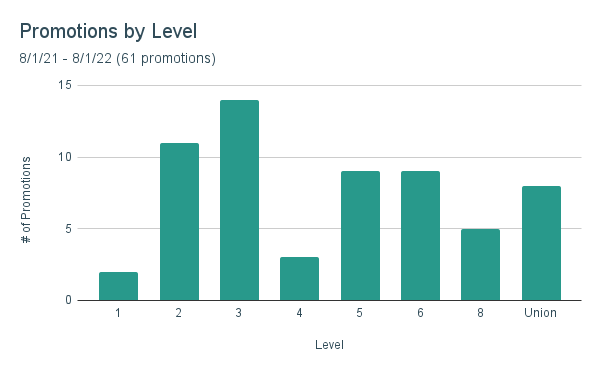
Note: A promotion is an increase in responsibility or job level that is usually accompanied by higher pay or increased hours (if not already full time). An offer of a temporary/on-call role to an intern or an offer of a regular role to a temporary/on-call employee is considered a promotion. We do not consider the offer of a limited-term temporary role to a temporary/on-call employee a promotion. Also, the terms on-call and temporary employee may be used interchangeably for this purpose.
Concerns Over Staff Resignations and Initiatives to Increase Retention
Mirroring a nationwide trend, KQED experienced a wave of voluntary terminations in the past 12 months (8/1/21 to 8/1/22). Voluntary terminations increased 60% over the prior year period. BIPOC staff departed KQED at a higher rate than white staff, repeating a downward trend at the station from the prior year. Female staff left KQED at a higher rate than males based on the overall population.
To reduce attrition and increase inclusion and belonging in the workplace, KQED added a “stay interview” component to the annual midyear check-in review process to help detect signs of disengagement earlier. We also made the exit interview process more robust and have reorganized and added more expertise to the HR department to increase touch points with staff and managers and to improve service. Additionally, in 2022 the CEO sent a twice monthly update to all staff on our DEI progress.
These improvements as well as our 154% increase in promotions, 360 feedback program for leadership, the onboarding of a Chief DEI Officer and our ongoing compensation transparency and equity initiatives may also increase retention of BIPOC staff. We are already seeing a drop
in overall resignations.
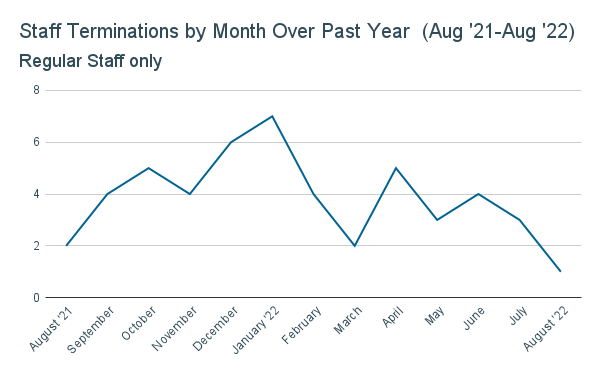
Leadership
Despite long-term efforts to recruit, retain and promote staff of color, BIPOC staff remain under-represented in KQED’s 103 leadership roles* at 33%. This represents a decrease from 34% BIPOC representation in these roles from August 2021. In the past 12 months, there were 14 open positions in leadership roles. A total of 64% of employment offers went to BIPOC leaders. During 2022, we lost 13 leaders of whom 61% were BIPOC. KQED leadership is currently 54% female, as it was in 2021.
*In this context, KQED job levels 4-8, which includes managers; directors; senior editors and producers; executive directors; vice presidents and C-level employees.
Looking Forward
In 2022, KQED advanced a number of initiatives to support DEI at the station. Although some long-term DEI initiatives were put on hold until a new Chief DEI Officer is in place, KQED was able to complete a number of critical action items set last year and set some short-term DEI goals. We also created a DEI vision using an inclusive process that allowed for contributions and engagement from across the station. Future initiatives will be focused on making our vision for diversity, equity and inclusion at KQED a reality, and will be led by our new Chief DEI officer with support from our leadership teams and KQED employees, including staff hired to support DEI initiatives and our Diversity Council.
